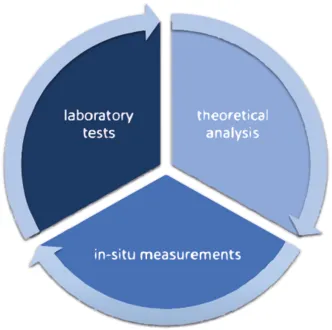Vehicle-Track interaction
The focus is set on a better riding quality of vehicles regarding roads and railway lines. These issues are connected both with a higher comfort and with reduced maintenance costs due to dynamic effects acting on infrastructure and rolling stock.
Modelling of the infrastructure (components, subsystems, systems and alignment) allows analysing the behaviour for the strains resulting from the volume of traffic or the climatic condition as well as the aging of the materials. Understanding the interaction of different infrastructure components and their relation with the running vehicles is a key for further improvements.
Besides theoretical investigations, the research strategy includes simulation and testing in laboratory and measurement in situ. The findings of these tests and measurements will give basic parameters and enable conclusions for simulation and calculation and vice versa. The direct interaction and the immediate feedback between laboratory tests and theoretical considerations are highly beneficial for successful solutions and innovations.
A main outcome of these investigations is the reduction of noise emissions and vibration at the source (wheel-road / rail-contact) and by respective superstructure design. Regarding human perception and the expectation on rail transport in urban environment, connected with the investment in Mass-Rapid-Transit and Light-Rail-Systems in our metropolitan regions this issue is becoming more and more important.
Rail and road superstructure
High speed railway lines with increasing speed and dynamic forces require improved tracks and installation procedures. Maintenance free lines for main line and urban rail infrastructure are the vision, based on the ongoing development of ballastless tracks.
Beside reliability, availability, maintainability and safety (RAMS) focus is set on the optimization of sustainable superstructure regarding ecological and economical renewal and maintenance of existing infrastructure. The possibilities to use recycling products and industrial by-products are investigated. Ecological and economic efficiency are going hand in hand.
A further issue is green-house gas balancing of construction, maintenance and renewal of road and railway infrastructure, including the energy efficiency of the infrastructure construction process as well as upgrading of existing railway lines for reduced travelling time by one own developed software-tools und the preposition of economy and reduced design and approval processes.
airfield constructions
dimensioning of airfield constructions
Klassifizierung von bestehenden Flugbetriebsflächen im Hinblick auf neue Flugzeugtypen
theoretical analysis
modelling of superstructure systems in finite element method
determination of system variables by current methods
static and safety analysis of superstructure characteristics
in-situ measurements
measuring of deflection by modified Benkelman beam
vibration characteristics of different superstructure systems
registration of rail strains under running bogies
laboratory tests
approval testing of components of superstructure
wheel tracking device for asphalt pavements
testing of elastomer for bearings
vibration protection on railways
